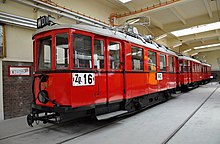Course (public transport)




In local public transport, the course is the smallest sub-unit of a line . If ten trains are in use on a line, this is served by ten courses. Alternatively, one speaks of laps , although a lap can change from one line to another in the course of the day and sometimes change its course number. This is how local transport companies differ from rail transport companies , which instead of using a fixed course number for all journeys on a day usually use numerous individual train numbers for only one single train journey . In some cases, regular journeys in local public transport, in contrast to an e-car or a special train , are also called through cars or scheduled trains , and the course book is also derived from this term.
The course number is primarily used for internal purposes by a transport company - for example for vehicle dispatching, personnel deployment planning and radio communications - and is therefore not always displayed publicly. If this is the case, it can usually be found on a small course number display behind the front or first side window of the driver's cab . This can be a plug-in sign ( called a course board or course sign ), a ring binder , a small scroll display or a digital display. The course number is usually not listed in the timetable documents . It also plays a role when driving on single-track routes according to the intersection plan. Here, the staff can check for oncoming trains if the turnout is the right turn was awaited or whether there is a delayed train and the train actually be waited still follows. In the case of the Magdeburg tramway, on the other hand, a course board crossed out with a red diagonal bar indicated that this train was not yet equipped for radio operation.
Application examples
The individual courses of a line are usually numbered consecutively, with a fictitious line 1 with ten courses, the following variants are possible:
| Version 1: | 1/1 | 1/2 | 1/3 | 1/4 | 1/5 | 1/6 | 1/7 | 1/8 | 1/9 | 1/10 |
| Variant 2: | 1-1 | 1-2 | 1-3 | 1-4 | 1-5 | 1-6 | 1-7 | 1-8 | 1-9 | 1-10 |
| Variation 3: | 11 | 12 | 13 | 14th | 15th | 16 | 17th | 18th | 19th | 110 |
| Variation 4: | 1 1 | 1 2 | 1 3 | 1 4 | 1 5 | 1 6 | 1 7 | 1 8 | 1 9 | 1 10 |
| Variation 5: | 1 | 2 | 3 | 4th | 5 | 6th | 7th | 8th | 9 | 10 |
| Variation 6: | I. | II | III | IV | V | VI | VII | VIII | IX | X |
| Variation 7: | A. | B. | C. | D. | E. | F. | G | H | I. | J |
The use of Roman numerals can be found, for example, on the Timișoara tram , it helps to avoid any risk of confusion between course and line numbers. The courses are usually numbered in ascending order in the order in which the vehicles left the depot in the morning . The coding is sometimes more complicated, however, so some operators differentiate between regular courses with low course numbers and amplifiers with particularly high course numbers or encode the responsible depot in the course number. For the Chemnitz tram , the morning rush hour courses were given the addition "-1" and the evening rush hour courses were given the addition "-2". In contrast, the full-day courses had no additions.
If a car is unexpectedly exchanged during the day, for example as a result of a defect, the replacement vehicle usually takes over the course number of the car that has been engaged. If, on the other hand, several vehicles are affected by a disruption, for example after a route closure due to an accident, it can also be that the schedule gets mixed up and several courses swap their timetable positions for the rest of the day.
In the case of the Frankfurt am Main tram , the background color of the course board - until the introduction of digital displays - also indicated which depot provided the respective car. In the case of the Würzburg tram , the colors express the operating day, with green for general working days, blue for Saturdays and red for Sundays.
Web links
Individual evidence
- ^ VEB Nahverkehr Karl-Marx-Stadt: Service and timetable for railcar drivers, summer 1980.
- ↑ The Würzburg tram on tramtom.de, accessed on July 18, 2016